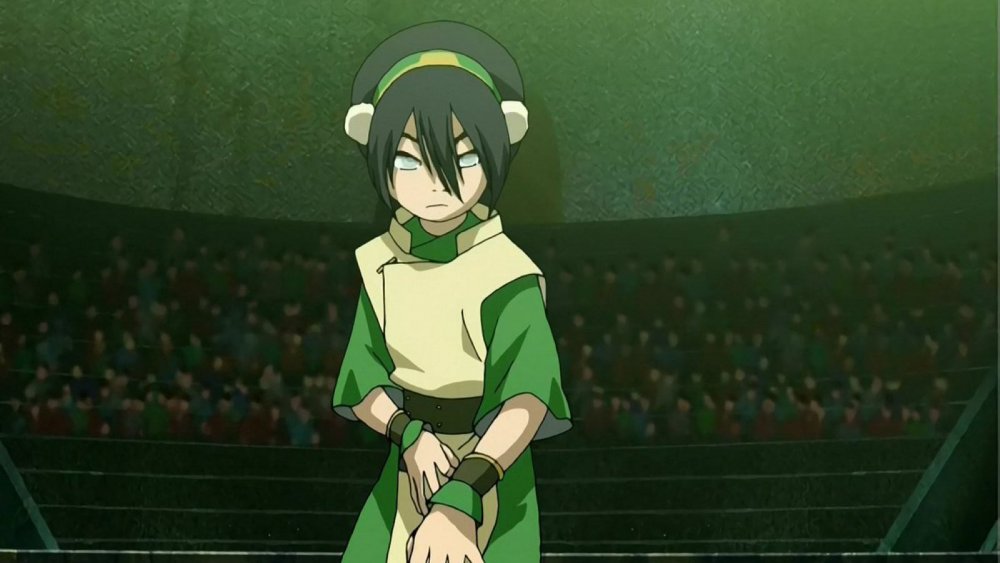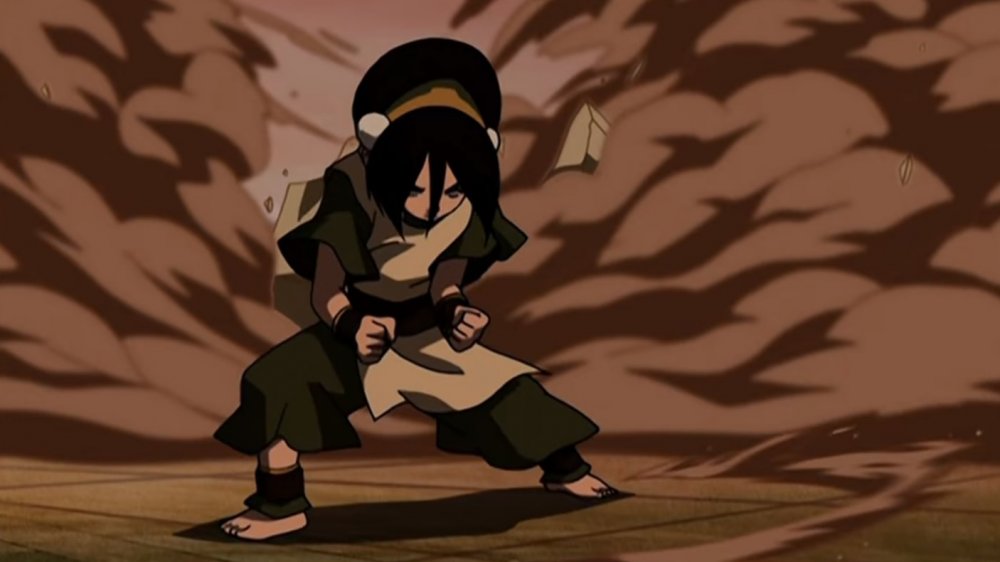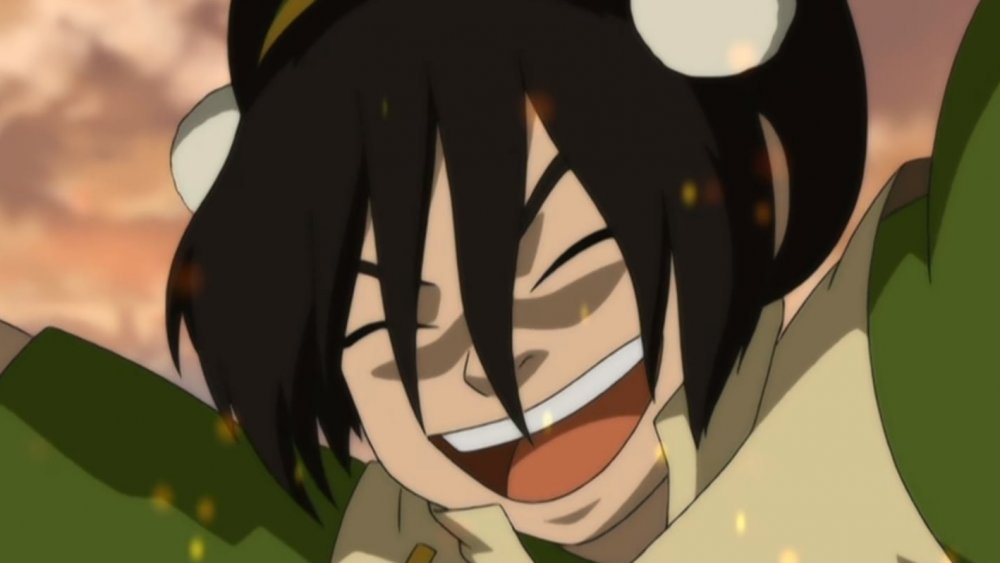What Avatar: The Last Airbender Fans Get Wrong About Toph Beifong
When a franchise and its characters get popular enough, fans tend to take things into their own hands. From fan fiction to fan art to fan-made videos, there's no limit to how far they'll take their creativity and express their appreciation for characters they love. There are positives and negatives to this level of extra attention, but that's a debate for another day.
Avatar: The Last Airbender's popularity is such that fans have made an indelible mark, especially after the renaissance it experienced in 2020 thanks to its Netflix debut. Between the show's gorgeous animation style, interesting and easily comprehensible magic system, and how well it handles its characters, the universe is ripe for fan obsession.
It goes without saying that the main cast receives the brunt of fan-borne attention, and for good reason. Well written, excellently voice-acted, memorably designed — what's not to love? The creators put a great amount of care into everyone from Azula to Sokka, and the fandom's enduring interest in these characters reflects that. Strangely, though, as pointed out by Tumblr user narrativelysignificantturtleduck, fans have a tendency to get Toph all wrong.
Avatar's Toph versus fans' Toph
Toph is first introduced in season 2's sixth episode, "The Blind Bandit." On the lookout for an earthbending instructor for Aang, Team Avatar attends Earth Rumble VI, a bending tournament featuring the Earth Kingdom's finest. Of everyone they see, the little girl calling herself the Blind Bandit impresses Aang the most — never mind the fact that she's eerily similar to someone he saw in a vision several episodes prior. She defeats an aggressive man twice her size with ease. Katara wonders how, but Aang gets it immediately: "She waited ... and listened."
The Blind Bandit isn't just a stage name: Toph is blind as a badgermole. Rather than a hindrance, the disability pushed her to become "the greatest earthbender in the world," as she calls herself. She relies on sound and feeling in place of sight, listening for and reacting to the vibrations of people and things around her. This patient style of fighting pays dividends, granting her pinpoint accuracy and an advantage over opponents who judge her by her size and lack of conventional vision.
Despite Avatar never straying from this aspect of Toph's character, this is where fans diverge from the source material. Tumblr user spookyikki notes that there is a "tendency towards painting strong women as bloodthirsty rage machines," using Avatar's own Kyoshi as an example. (Kyoshi is more complicated than that, especially factoring in F. C. Yee's book duology about her, but that's beside the point.) Agreeing with the point, narrativelysignificantturtleduck emphasizes that Toph's "fandom characterization is 'chaotic murder child!'"
Put simply, many fans' conception of Toph is that of a powerful young lady who destroys everything and everyone in her path with her unmatched earthbending prowess, topping victories off with a mock-evil laugh. If she had an army charging at her, fans might say that she'd barrel right through it — no mercy. When faced with the small army guarding the Earth King's palace in episode 18 of season 2, Toph's countermeasures are in fact much more creative and careful. It's not like every earthbending move she performs is subtle, but fans tend to neglect Toph's fundamentals: the ability to listen to the ground beneath her feet and land precision strikes. But where do they get this image of her from, exactly?
Little girl, big personality
Like all Avatar characters, Toph's personal history is integral to how she chooses to present herself. Pampered as the daughter of the prominent Beifong family, she lived a sheltered childhood that saw her opportunities for personal growth greatly restricted. She learned earthbending not from masters, but from badgermoles, enormous creatures she encountered in a cave after running away at a young age. "For them," she says to Team Avatar, "the original earthbenders, it wasn't just about fighting: it was their way of interacting with the world." Thus, her inimitable bending style.
Living as the Beifongs' precious little girl while simultaneously knowing how earthbending could expand her horizons is what led to Toph developing her Blind Bandit persona: a name-calling loudmouth who doesn't deal with anyone's garbage. It's that very persona that fans latch on to, making Toph out to be this ball of limitless energy and potential that doesn't stop rolling for anything.
It's understandable in a way, as many of the most memorable Toph moments see her loudly proclaiming something or other to friends and enemies alike. Her larger-than-life personality is so prominent, in fact, that it even carries over to how she interacts with Korra in Avatar's sequel series The Legend of Korra. Yet aside from forgetting Toph's unique approach to combat, these fans also effectively sidestep all of her character development over the course of the show.
People are prone to change how they act depending on the situation and those around them, and Toph is no different in that respect. She's got a big mouth most of the time, but in Avatar's quieter moments — such as when she recounts her earthbending origins — it becomes abundantly clear that she's more than she seems. Depicting Toph as a "chaotic murder child" doesn't quite line up.
At the end of the day, though, fans are free to do whatever they wish — and more power to them. Inaccurate or not, their love of Toph is a testament to the character and the show she hails from.


